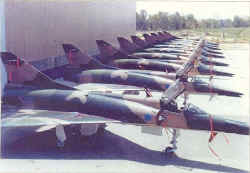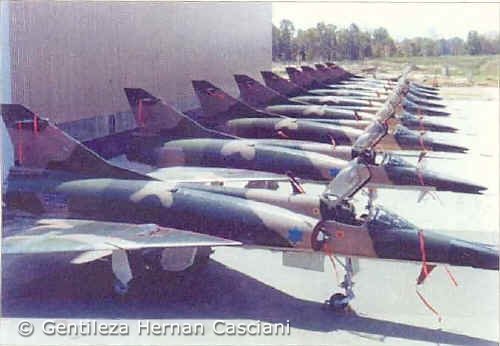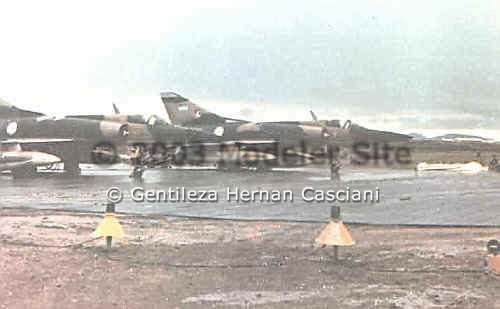|
Legal Notice
No material from Modeler Site any Web site owned, operated, licensed, or controlled by Mario Covalski & Associated may be copied, reproduced, republished, uploaded, posted, transmitted, or distributed in any way, except that you may download one copy of the materials on any single computer for your personal, non-commercial home use only, provided you keep intact all copyright and other proprietary notices. Modification of the materials or use of the materials for any other purpose is a violation of Mario Covalski & Associated's copyright and other proprietary rights.
Read More here > Legal notice
Useful information for modelling > Here
Moveable Squadron II "La Marinette" - May 1st, 1982
Early on May 1st, the airport at Puerto Argentino (Port Stanley) was hit by bombs dropped by a RAF Vulcan and several low flying Harriers. Some damage was done to the landing strip and the infrastructure and planes parked in the area.
The FAA answered with several air patrols, including 3 done by A-4C PACs, armed with Shafrir missiles. At 9:40, the Commander of the Task Force asked for the surrender of the Argentine garrison. When the movement of helicopters and small ships around Puerto Argentino made believe the defenders that a landing operation was being carried out, the FAA commanders decided to launch a counter attack on the 3 ships that had started shelling the island at 14:25 hs. First section of planes took off at 15:23 and their mission was to protect the planes that were going to bomb the naval formation.
Among all the planes that took part in this air strike, we will center our attention around two Mirage 5 Dagger sections: Tornos and Fortines. The first ones were armed with 2 bombs in the stations placed under the posterior part of the fuselage and 3 x 1300 lts fuel tanks, which gave them scarcely 2 minutes flying time over the area of operations. They were:
Captain Dimeglio in C-432,
Leutenant Aguirre Faget in C-412 and
1st Leutentant Román in C-407.
|
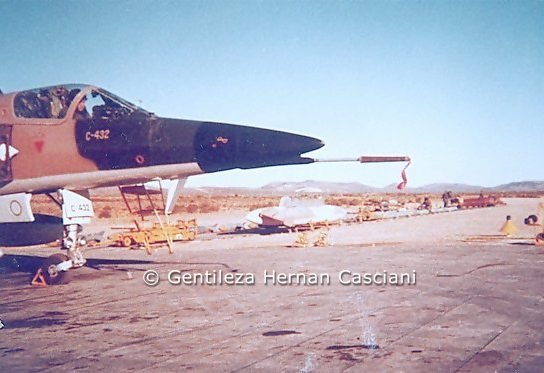
|
|
C-432
|
Fortines had external fuel tanks and 2 Shafrir missiles. Pilots in this section were Captain Donadille (flying C-403) and 1st Leutenant Senn.
All these planes were stationed in San Julián, and were part of the Moveable Squadron II "La Marinette"
Tornos, after taking to the air at 14:45, would descend to sea level after flying 40 minutes over the South Atlantic waters and 200 kilometers away from the islands. But when approaching the Sebaldes islands, the air controller at Puerto Argentino warned them about the presence of a Harrier CAP that was heading in their direction. Therefore, their descent was steep and fast, until they were lost from detection from the British planes. According to the orders they had received in Orden Fragmentaria 1105, the vessels were shelling Puerto Argentino from Bahía de la Anunciación. Skimming the waters, they flew past the northern mouth of Falkands Sound (Estrecho de San Carlos) and when they reached Corrientes point they turned South, searching for their targets. The sea was calm and the ceiling was 500/1000 feet. Suddenly, number 2 saw a Harrier climbing into the
cloud. It was one of the planes that had just fought against the Mirage III EA (Dardo section). After loosing his number 2 shot down in combat, Cap. García Cuerva, short of fuel and with his plane untouched (contrary to the British version) and who had dog fighted against the Harrier seen by the Tornos (flown by CT (RN) Robert Thomas) was killed by the Argentine AA guns while trying to make an emergency landing in Puerto Argentino. His eager to save his plane had costed him his life.
Another pilot that gave his life and distracted another British CAP was 1st Leutenant Ardiles who was shot down flying alone against the SHARs. Just minutes before this combat, he had straffed two british war ships with his 30 mm guns, forcing them to desist from their intention to enter Falkland Sound from the South.
These 4 Harriers could have interfered with the Tornos...
Now, let's go back to the 3 Daggers flying a few meters above the waves at 800 km/hr. Soon they arrived at "Bahía de la Anunciación" but to their disappointment they found it empty. A quick glance to his fuel indicator told DiMeglio that they could still fly some minutes to the South before returning to the continent. The planes were flying in line abreast and 150 feet away from the others.
Meanwhile, 30.000 feet above....
...the Fortines were slowly flying over Falkland Sound, waiting for the Tornos to finish their mission. With gentle turns they were covering each other's tails. Due to an electrical failure, the guns in Donadille's plane were useless. This fact was discovered when they tested their guns on the way to the islands. Nevertheless, the leader decided to go ahead, armed only with 2 Shafrir missiles.
On the radio they were able to listen to the communications between García Cuerva and the Air Controller at Puerto Argentino...how the anxious argentine gunners started firing against approaching Mirage when he ejected his external loads….Shocked by the last words said by García Cuerva, the Fortines flew on. Meanwhile, the flaming Mirage and his brave pilot were falling close to Puerto Argentino.
16:35 hs, 50 feet above the water, close to Puerto Argentino
Torno 3 saw some explosions on the water. He realized that those were the British guns firing against the argentine positions. He told DiMeglio about this, who ordered them to attack the ship ahead of each other. The naval formation was milling in a circule 8 km SE of BAM Malvinas, one behind the other, and were calmly shelling Puerto Argentino. Nine kilometers to the North, the Daggers were closing in on their targets...40 seconds to drop their bombs. When faced by the planes, the destroyer was at the left (target for Aguirre Faguet), one Class 21 frigate at the center (target for Dimeglio), and the other one at the right (target for Román).
Flying at no more than 10 feet above the water, the M5s accelerated and approached the ships. Dimeglio attacked the ship assigned to Aguirre Faguet because it presented and easier target and therefore, more appealing.
When they were close to the ships the pilots, except Torno 3, started firing their guns. Torno 1 and 2 attacked the destroyer from POPA. After dropping his armament, Dimeglio inverted his plane and put his wings perpendicular to the sea. Flying this way he passed between some antennas, then turned right and found that he was facing his originally assigned target. He shot the last rounds he had against it and flew as close as he could to the ship attacked by Román. Eventually, he was over land and after some miles, he climbed to the clouds.
Román also turned to the left after dropping his bombs and headed for the continent while climbing. Neither of them could see the result of their bombs as they were quickly left behind because they had parachutes to slow down their speed. But flying behind and to the right of Aguirre Faguet, Román saw the effect of his companion armament.
Aguirre Faguet decided to lift his plane a little to aim better. He climbed to almost 3000 ft. From the ground they saw how he was hotly attacked by the ships as he presented an easy target. A Sea Cat fired from the frigate on the center passed harmlessly below the Dagger. The pilot didn't see it, focused as he was on his target, and was later told about this near miss. Aguirre dropped his bombs while diving on the ship and then turned left into the open sea at naught feet. Román saw Aguirre Faguet's bombs exploding with fire and smoke, close to the destroyer. This fact was also seen by people on the ground.
Though it's hard to believe, none of the planes was hit by the defensive fire put up by the ships.
Abroad the ships
The lightning approach of the planes took the defenses almost by surprise. In fact, their guns started firing at the last moment. Then the guns fire was intense.
Frigate HMS Arrow was hit by several 30mm ammo and the destroyer by the bombs dropped by Torno 2. Listing and on fire, one of the frigates came to her side to assist her. Then the destroyer slowly left the area, following the frigates that were sailing at full speed. Still emiting smoke, the ship was lost in the horizon. At 17:10, a message intercepted by the argentine garrison said "Destroyer D-42...requesting help to HMS Invincible"
On the ground
Witnesses were astonished to see how the planes survived the defensive armament fired by the ships. The ROA and members of the Argentine Navy saw a flash on the bigger ship and it started emitting smoke.
Numerous are the officers (among them members of ROA, Lt. Jorge Reyes and Major Hugo A. Maiorano, in charge of the AA guns of BAM Malvinas and officers of the Navy like Lt. Rodolfo Cionchi who saw the attack from Sapper Hill) who maintain that it was a Type 42 destroyer and not HMS Glamorgan the ship that was hit hard. The Type 909 radomes and the big square antenna are unmistakable. It's important to say that this type of ship is no stranger to this THESE men, as the Argentine Navy had 2 in service at the time of the conflict (Santísima Trinidad and Hércules) and DiMeglio had not only practiced against them before the arrival of the Task Force, but had indeed been abroad one of them.
An unexpected witness
Flying in his A-4B south of the islands and after having attacked by mistake an argentine ship, Capt. Carballo of the V Brigada Aérea of FAA decided to return to his base in the mainland taking the northern route. Close to Puerto Argentino he found a ship covered in smoke. This made him change his mind and he return using the same route he had taken before. Though the darkness that was falling didn't allow him to take a good look of this ship, it cannot be denied that it was the same D-42 that had retreated from the waters in front of Puerto Argentino.
A "rocking" return
While climbing at 20000 ft and still above the islands, the CIC at Puerto Argentino warned the Tornos that another CAP was following them (the second one!). Torno 3 didn't hear it and kept on flying steadily, while his other 2 companions went down and hid under the clouds beneath…to find that they had survived by a miracle: they were in a valley, surrounded by the mountains (Mt. Simon and Rivadavia). Still supersonic, Dimeglio decided that they were using too much fuel and they both climbed again when they reached San Carlos Waters. Their flying altitudes now were: Torno 1 42000 ft, Torno 2 21000 ft and Torno 3 30000 ft.
Now yet another CAP (the third!) arrived in the scenery and started to pursuit Torno 2. The Argentine controller at the CIC kept telling them how this new threat was closing in, but Aguirre Faguet could not hear them and did not know that he was in danger.
Meanwhile, Buitres, another Mirage IIIEA section, was attracting and bating another CAP.
Race against the time....
Eventually, the CIC decided to send the Fortines in persecution of the pair of Harriers that was following Torno 2. They ejected their external tanks and accelerated to 1.4 Mach.
Radar kept on feeding them with the distances between Torno 2 and the CAP, and the CAP and themselves.
When the British were 3 miles away from Aguirre, Fortines were 2 miles behind the CAP. But the heading they were flying to (320 º) put the sun in front of them. Therefore, their missiles were homing on the sun and Donadille could not fire his guns: their only armament was the 30 mm cannons of Senn.
As they were flying faster than the Harriers and the sun was affecting their vision, the pilots of the Daggers were afraid of over passing the CAP and becoming hunted instead of hunters.
At the moment that the distance between the CAP and the Fortines was 1.5 miles and it seemed that a dramatic end would happened, the British pilots, probably alerted by their own controller, made a Split S and left the persecution of Torno 2.
It was the end of a 150 km persuit.
Return of the warriors
As they did not have modern navigational equipment, all that the Dagger pilots could do to get back home was point the nose of their planes in the direction of the continent and guess their distance to their base by the time they had been in the air. Dropping their remaining external tanks to minimize the fuel usage, allowed them to reach San Julian with just enough "juice" to land.
The happiness of the accomplishment was somehow dimmed with the deaths of García Cuerva and Ardiles.
The first attack on the supposedly "invincible" British naval formations had been successful and a myth had died.
Puerto Argentino, after the attack
The two frigates left the zone, slowly followed by the destroyer who was still emitting smoke. According to Admiral Woodward, the smoke seen by the observers on the ground could have been the one produced by the guns while firing and not the bombs, or the one of the Olympus turbines instead of a burning ship. When she was lost in the horizon, the smoke could still be seen.
Around 18:30 hr, when night had fell, the same witnesses at mount Low heard a series of explosions in the direction the naval formation had gone. At first they thought that a battle between ships was taking place as the horizon lit up with several flashes. At 23:00, the explosions and lights in the horizon ceased.
Final opinions, 21 years after
The FAA is sure that the British Naval force was formed by two Class 21 Frigates and 1 Type 42 Destroyer. Regretfully, none of the 3 cineguns worked during this attack.
There are three theories about what happened:
A) The Destroyer was HMS Exeter, which reappeared in the conflict area some weeks later, to shoot down one Recco LearJet (T-24) of Squadron Fenix of the FAA.
B) Bombs dropped by Aguirre Faguet hit HMS Sheffield. She was so damaged by the explosions that could not defend herself and was hit by the Exocet on May 4th
C) HMS Sheffield was sunk on the night of May 1st and the British answer was the sinking of ARA General Belgrano the following day (and, by the way, the peace plan proposed by the Peruvian Govt. that had been accepted by Argentina and United States was then impossible to maintain after such an aggression).
According to British sources, the ships that were shelling Puerto Argentino were County Class Destroyer Glamorgan (hit on June 13th by a land Exocet and almost destroyed) and frigates Alacrity and Arrow. Glamorgan suffered minor damages, Arrow took 8 x 30 mm hits and the hull of Alacrity was affected by the close explosion of a bomb, which produced some water entering her, but this soon was repaired. Even more, the sailors abroad these ships sustain the official version and maintain that it is a recognition mistake by the Argentines.
But what cannot be denied is that the British naval formations were not invulnerable, that their defensive fire was not perfect and that they could be hit. Only once more the Taks Force tried this kind of attack, and HMS Glasgow was hit by a bomb that did not explode dropped by Skyhawks of V Brigada Aérea, but the whole HOLE it had made it impossible to keep on fighting for the rest of the war.
Useful information for modelling
Being a site for modellers, we cannot stop giving you the information you need to build a Dagger.
There is no kit that allows you to represent without problems one of these Mirages. In 1/72nd you may buy the Pioneer 2 kit, made in Turkey, but the nose must be sanded to resemble a Dagger. It also has some very big fit problems.
In 1/48th you can use the Esci kit, but a resin nose must be purchased.
More important modifications must be done to the Heller kit >Note 1 >Note 2
In the case of the argentine planes, you must always check your references and pictures of the specific plane you want to build, as they all have subtle differences, though the basic scheme is followed in all the cases.
FAA Daggers were painted in the SEA (South East Asia) scheme, as the one used by the USAF during the Vietnam war. Therefore, semi gloss paints were: Tan and two different Greens for the upper surfaces and fuselage, and White for the lower half. The lines between the colors were soft and the ones dividing the upper and lower areas could be waving or straight.
Nose was painted in black (sharp line), except for the pitot that could be bare metal. Both VHF antennas were painted according to the color of the area they were places (white below the nose, tan behind the cockpit), though there are pictures of Daggers with latter in light grey.
The internal face of the air intakes was white.
The upper area of the tail could be painted light grey with a thin black outline or in the cammo colors without this black detail. Same applies to the forward fillet of the tail. The two little antennas on top of the tail were painted white (undersurface) and tan or white (uppersurface). The cone of the parachute store was bare metal or silver. Both sides of the tail had a badge: on the left side the one of Grupo 6 de Caza, the right side had the one of the Grupo Técnico 6. Not all the planes had both badges.
The wings had thin red lines along the root, delimiting the elevons and a big triangle around the air brakes.
The main insignia were: roundels of 60 cm diameter in the fuselage, under the right wing and above the left one. A flag of 60 x 40 cm was painted on the tail, though not all the planes had it in the same position. As an example, C-421 had it painted in a lower place. The words Fuerza Aérea Argentina were painted in black on both sides of the nose under the serial number which was painted in the reverse colors to the fuselage ones (tan letters over green or green letters over tan). The upper front nose door had the serial number painted in black.
The main serial number was painted in the rear area of the fuselage, between the roundel and the exhaust. It could be black (in only some planes as C-419 and C-420) or in the inverted fuselage colors. The left side numbers were painted in tan, but the right hand ones they could be completely green or parts of green and parts of tan (when the numbers were painted above both colors on the fuselage). IE: C407 and C-414.
The external fuel tanks were painted in tan and green, while the undersurfaces were white. Also, some unpainted tanks were used, and from May 22nd, Israeli external tanks with the desert scheme (tan and sand) were used. These were brought to San Julián via Perú and they had writings done by the Peruvians like "Denles duro, ches" (Hit them hard, Ches) and other ones about the British.
During the war, some of the planes were given war names, like C-410 ("Vikingo") and C-419 ("Boomerang", for it to return every time, but it was destroyed by a Sidewinder on May 24th and his pilot, Lt. Castillo, was killed). These names were painted in the lower front door of the nose landing gear.
On April 28th, before the war started, yellow identification bands were painted on the planes. They were 1 meter width and placed on top and under the wings, and on both sides of the tail. Planes that received the bands at San Julian on this date were C-404, 407, 412, 421, 434, 432. In same cases, the bands covered the flags and in other cases the bands were painted around the badges and flag.
|
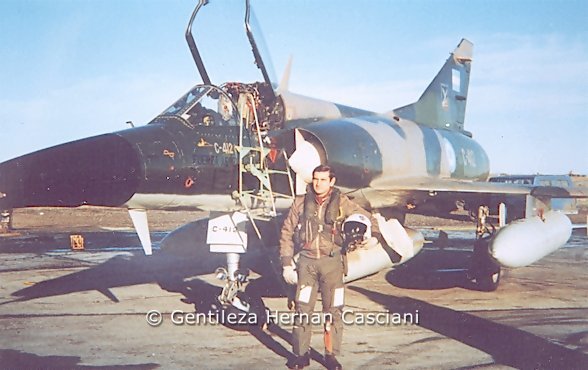
|
|
C-412
|
External tanks also received a hand of yellow paint on their undersurfaces.
C-407 y al 434 were the first to fly over the Malvinas on a familiarization flight on April 16th and therefore received a drawing of the Malvinas Islands painted in yellow-greenish paint over the left side air intake, with the words "Islas Malvinas" under the drawing.
On May 24th orders were received to overpaint the ID bands in green. The only available paint was a color depicted as "green bluish" (turquoise), which was brush applied during the night. The planes that were at San Julian that night were C-419, 430, 410, 420, 421, 434, 416, 432 y 411.
Some planes had their tail bands overpainted with air brush in a lighter tan color, approx. FS 33690.
And to finish this reference, the kill marks were painted on the left side of the nose and where designed by Exequiel Martínez, a retired FAA helicopter pilot who carried out SAR missions during the war. They could be white, yellow or sometimes they had the Union Jack as well. To represent a damaged ship, only half of the silhouette was completely painted. First planes to get these kill marks were the Tornos. Regretfully, these drawings where lost when the Daggers were converted to the Finger standard and received a coat of light grey.
Color Chart - approximate colors
|
Color
|
FS aprox
|
Humbrol
|
Tamiya
|
Testor
|
Mo-Lak
|
|
Dark Green/ Forest Green
|
34102
|
116
|
XF61 (66 %) + XF65 (34%)
|
1713
|
LU7
|
|
Light Green
|
34079
|
117
|
XF27 o 61
|
1710
|
LU8
|
|
Tan / Red Brown
|
30219
|
118 / 119
|
XF52
|
1742
|
LU9
|
|
Yellow
|
33538
|
154
|
X106
|
1708
|
|
|
Turquoise
|
35200
|
48
|
X14
|
|
|
|
White
|
26622
|
22
|
X2
|
1745
|
1
|
You must check the plane you want to build, as weathering produced subtle changes.
Bibliography
 Modelshow N12 y N13 Magazine Modelshow N12 y N13 Magazine
 IPMS Stockholm IPMS Stockholm
 Dagger & Finger, Núñez Padín Dagger & Finger, Núñez Padín
 Dios y los Halcones, Pablo Carballo Dios y los Halcones, Pablo Carballo
 Halcones sobre Malvinas, Pablo Carballo Halcones sobre Malvinas, Pablo Carballo
 La Guerra Inaudita, Rubén Moro La Guerra Inaudita, Rubén Moro
 La Batalla Aérea de nuestras Islas Malvinas, Pío Matassi La Batalla Aérea de nuestras Islas Malvinas, Pío Matassi
 Aeroespacio N534 Aeroespacio N534
 Ellos también combatieron, Guillermo Posadas Ellos también combatieron, Guillermo Posadas
 La Fuerza Aérea en Malvinas, Tomo I La Fuerza Aérea en Malvinas, Tomo I
 The Falklands War, Duncan Anderson The Falklands War, Duncan Anderson
 Harrier over the Falklands, Nigel Ward Harrier over the Falklands, Nigel Ward
 Guerra Aérea en las Malvinas, Benigno Andrada Guerra Aérea en las Malvinas, Benigno Andrada
 Reportaje al Vicecomodoro DiMeglio en Canal Marín, Buenos Aires, 2002 Reportaje al Vicecomodoro DiMeglio en Canal Marín, Buenos Aires, 2002
Condor Decals provides decals for Malvinas/Falklands airplanes, in 1/72 and 1/48 scale. > Here
|
Set 72005 and 48005
|
Set 72007 and 48007
|
|

|

|
|
More details > Here
|
|

